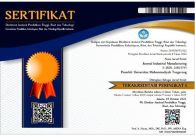PENERAPAN KAIZEN UNTUK MENGURANGI LOSS TIME DALAM PENINGKATAN PRODUKTIVITAS MESIN INFRARED WELDING (STUDI KASUS PT. MITSUBA INDONESIA)
Abstract
PT Mitsuba Indonesia is a factory engaged in the manufacture of electrical automotive spare parts. The LED winker lamp is the newest product whose production demand is always increasing. The large demand for LED winker lamp products must of course be balanced with the readiness of production machines which are always in good condition. But in practice, the results of the production achievement are still low, this is due to the high machine loss time, especially in infrared welding machines. This study discusses the application of kaizen which aims to find the causes of loss time, make improvements in order to reduce loss time and determine loss time and productivity after repairs are made. The method used to analyze the causes of loss time is to calculate the value of six big losses and analysis of the cause and effect diagram. The analysis results showed that the idling minor factor and stoppages losses caused by part drop error and the set up and adjustment losses factor caused by a change in the type of production jig. Improvements made to the part drop error were adding 1 set of regulators. Meanwhile, the change in the production jig type is to modify the locking system on the lower and upper heater jig. Based on these improvements, it was able to reduce the loss time to 4.86% and productivity to increase 7.50% in July. Loss time fell 4.70% and productivity increased 7.90% in August.
Keywords: LED winker lamp, infrared welding machine, loss time, six big losses, productivity.
Full Text:
PDFReferences
Arif, M. S., Putri, C. F. and Tjahjono, N. (2018) ‘Peningkatan Grade Kain Sarung dengan Mengurangi Cacat Menggunakan Metode Kaizen dan Siklus PDCA pada PT . X’, Jurnal Widya Teknika, 26(2), pp. 222–231.
Darmawan, H., Hasibuan, S. and Purba, H. H. (2018) ‘Application of Kaizen Concept with 8 Steps PDCA to Reduce in Line Defect at Pasting Process : A Case Study in Automotive Battery’, International Journal of Advances in Scientific Research and Engineering, 4(8), pp. 97–107.
Depvi, T. S. (2017). Analisis Strategi Pemasaran dan Pengembangan Usaha Pada Sentra Industri Mebel PT. Pandu Wira Desa Sukorejo Kecamatan Bojonegoro Kabupaten Bojonegoro. Skripsi. Fakultas Ekonomi, Universitas Bojonegoro.
Fatkhurrohman, A. and Subawa (2016) ‘Penerapan Kaizen Dalam Meningkatkan Efisiensi Dan Kualitas Produk Pada Bagian Banbury PT Bridgestone Tire Indonesia’, Jurnal Administrasi Kantor, 4(1), pp. 14–31.
Gani, A. J. and Bendatu, L. Y. (2015) ‘Perbaikan Proses Dandori di PT. Astra Otoparts Tbk . Divisi Adiwira Plastik’, Jurnal Titra, 3(2), pp. 1–8.
Ihsan, M. (2019) ‘Fanuc Cnc Machine Damage Analysis Using The Pdca Cycle And Kaizen Implementation Effort In Increasing Skill Up Operator Performance In Pt Ypmi’, Independent Journal Of Management & Production (IJM&P), 10(February), pp. 259–280.
Imai, M. (2001). Kaizen (Ky’zen): Kunci Sukses Jepang Dalam Persaingan, Cetakan kelima, diterjemahkan oleh Dra. Mariani Gandamihardja. Penerbit PPM.
Kapuria, T. K., Rahman, M. and Haldar, S. (2017) ‘Root Cause Analysis and Productivity Improvement of An Apparel Industry in Bangladesh Through Kaizen Implementation’, Journal Aprie, 4(4), pp. 227–239.
Kartika, H. (2020) ‘Lean Kaizen untuk Meningkatkan Produktivitas Line Painting pada Bagian Produksi’, Jurnal Sistem Teknik Industri, 22(1), pp. 22–32.
Kurnia, I. and Suryanto (2018) ‘Efesiensi Waktu Kerja Proses Packaging dengan Metode PDCA (Plan Do Check Action) di PT Lemindo Abadi Jaya’, Jurnal Teknik Industri. Universitas Krisnadwipayana, pp. 10–20.
Nagaich, R., Tiwari, L. and Sahu, S. (2020) ‘Productivity Improvement By Kaizen : A Case Study In A Tyre Company’, Industrial Engineering Journal, 13(2), pp. 1–12.
Pinasthika., A. (2018). Analisis Perhitungan Overall Equipment Effectiveness (OEE) Guna Mengurangi Six Big Losses Dan Upaya Perbaikan Dengan Pendekatan Kaizen 5S (Studi Kasus: PT.PINDAD (PERSERO). Skripsi. Fakultas Teknologi Industri, Universitas Islam Indonesia.
Rizqilah, C., Silviana and Hardianto, A. (2019) ‘Penerapan Konsep Continuous Improvement Untuk Mengoptimalkan Penggunaan Energi pada Mesin Pengering ( Dryer Device) di RTC Line PT . HM’, Jurnal Conference on Innovation and Application of Science and Technology. Universitas Widyagama Malang, (Ciastech), pp. 225–230.
Roro, R., Herdiana, L and Husniah, H. (2020) ‘Analisis Perhitungan Overall Equipment Effectiveness Guna Mengurangi Six Big Losses dan Upaya Perbaikan Dengan Pendekatan Kaizen 5S’, Jurnal TIARSIE, 17(2), pp. 53–56.
Sari, L. P., Islamuddin and Finthariasari., M. (2020) ‘Pengaruh Etos Kerja Dan Lingkungan Kerja Terhadap Produktivitas Kerja Karyawan Pada Industri Kerupuk As-Syifa Kota Bengkulu’, Jurnal Entrepreneur dan manajemen Sains (JEMS), 1(2), pp. 216-221.
Setiawan, D. (2019) ‘Peningkatan Kapasitas Produksi Mesin Press pada Panel Front Door Outer RH Sebagai Upaya Meningkatkan Produktivitas Press Shop pada Industri Otomotif’, Jurnal Integrasi Sistem Industri, 6(1), pp. 37–43.
Sharma, P., Sharma, N. K. and Singh, M. P. (2015) ‘Process Improvement By Implementation Of Kaizen As A Quality Tool Within Defined Constraints : A Case Study In Manufacturing’, International Journal of Science and Technology, 1(1), pp. 182–194.
Sinungan, M. (2014). Produktivitas Apa Dan Bagaimana. Jakarta: PT Bumi Aksara.
Siswandi and Karomah, N. G. (2019) ‘Implementasi Sistem Keizen Departemen Produksi PT Yamaha Music Manufacturing Asia Bekasi - Jawa Barat’, Jurnal Akuntansi dan Bisnis, 5(01), pp. 1–17.
Suwardiyanto, P., Siregar, D. and Umar, D. (2020) ‘Analisis Perhitungan OEE dan Menentukan Six Big Losses pada Mesin Spot Welding Tipe X’, Journal of Industrial and Engineering Sistem (JIES), 1(1), pp. 11–20.
DOI: http://dx.doi.org/10.31000/jim.v6i1.4114
Article Metrics
Abstract - 8253 PDF - 8943DOI (PDF): http://dx.doi.org/10.31000/jim.v6i1.4114.g2352
Refbacks
- There are currently no refbacks.













